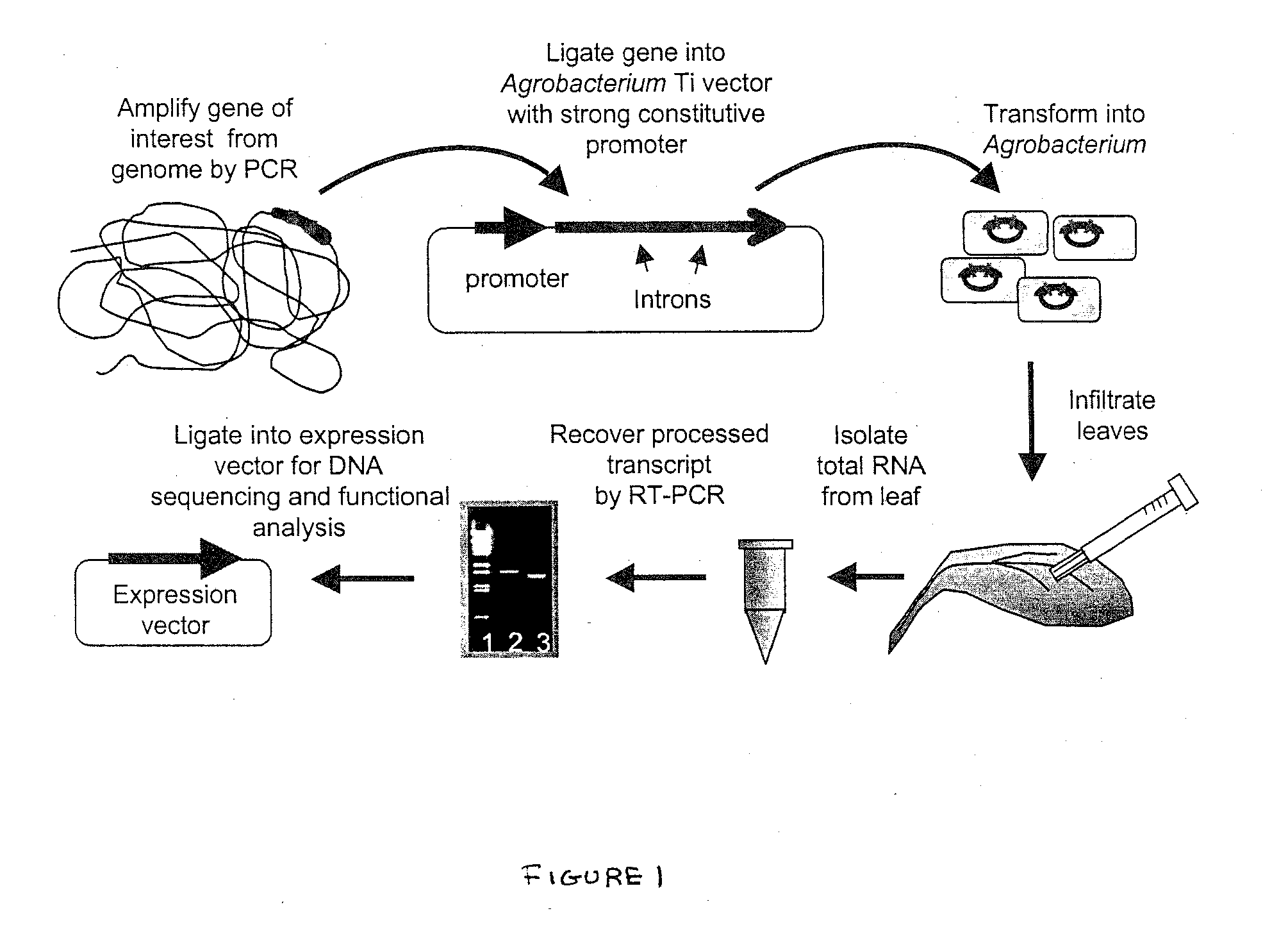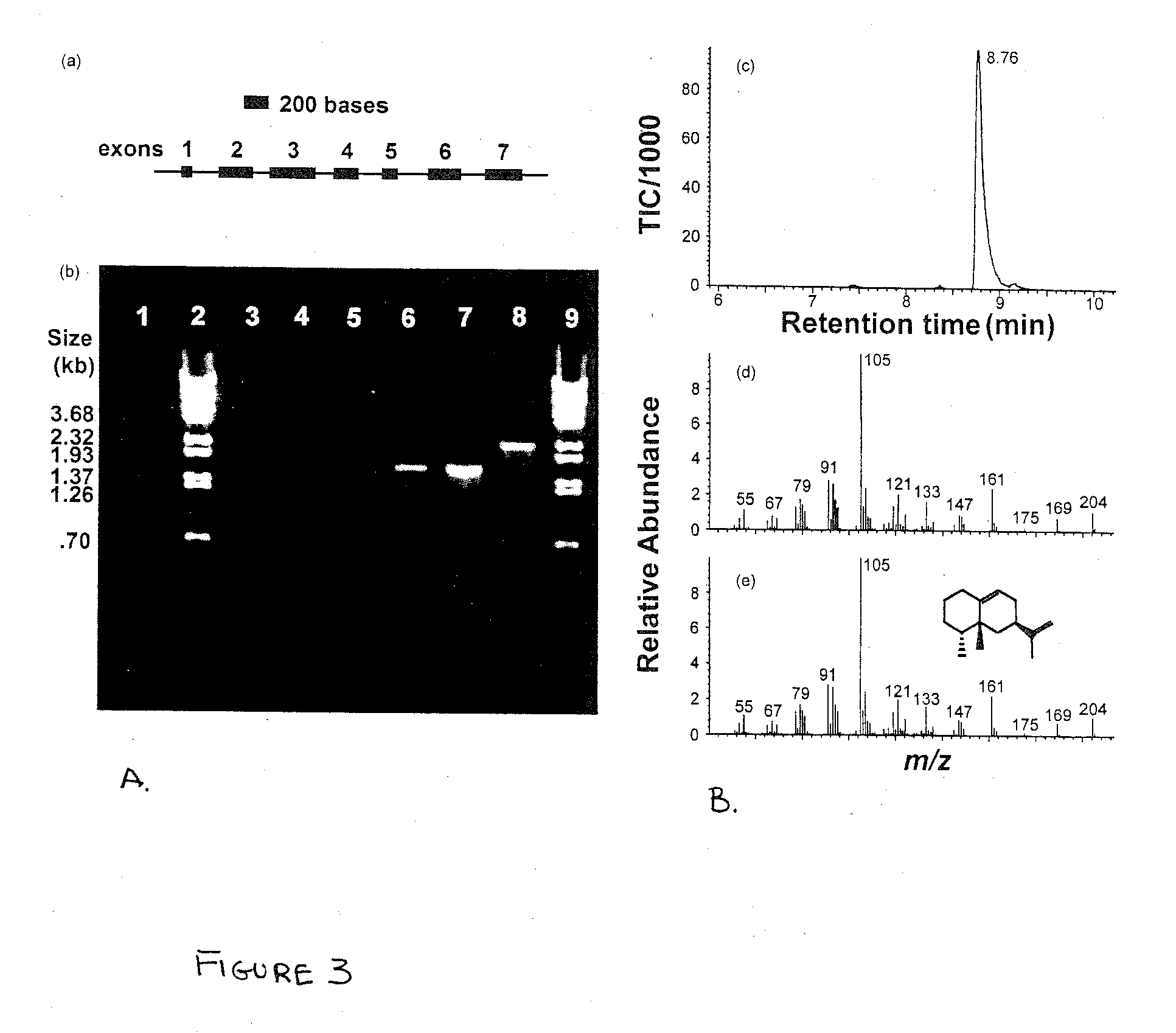Methods for Splicing Plant Genes
a plant gene and intron technology, applied in the field of splicing plant genes, can solve the problems of insufficient splicing of plant genes, inability to accurately process plant genes by other eukaryotic cells, and inability to remove plant introns
- Summary
- Abstract
- Description
- Claims
- Application Information
AI Technical Summary
Problems solved by technology
Method used
Image
Examples
example 1
[0028] The time course for petunia mesophyll cells taking up and expressing T-DNA-borne transgenes following agroinfiltration was determined in leaf disks collected at daily intervals, and tested quantitatively for GUS enzyme activity (FIG. 2B). Detached petunia leaves were infiltrated with a suspension of A. tumefaciens carrying the intron-containing GUS gene (GUSI) driven by the cassava vein mosaic virus (CsVMV-GUSI) promoter, characterized for its ability to direct strong constitutive expression in leaf tissue (Verdaguer et al., 1998). GUS activity was absent or barely above background levels for the first two days after infiltration, then increased dramatically and almost linearly over the next four days. Maximum GUS activity was observed by six days post agroinfiltration and declined rapidly thereafter. The time course for transient expression of GUS activity in petunia is consistent with those previously reported for other plant species (Van der Hoorn et al., 2000). The absolu...
example 2
[0029] Recovery of a full-length cDNA from petunia leaf tissue agroinfiltrated with the GUSI gene was used to further assess the utility of this system for the generation of properly processed transcripts (FIG. 2b). Total RNA was isolated using a standard isolation procedure and 5 μg used for first-strand cDNA synthesis with an oligo-dT primer. An aliquot of the first-strand synthesis reaction was then used in combination with primers designed to bracket the start and stop codons of the GUS gene and containing convenient restriction sites for future insertion of the PCR fragments into suitable prokaryotic expression vectors. Single-primer, RNA-only, and template-less controls showed no amplification products (lanes 4-7), while the complete experimental reaction yielded a reaction product that was approximately 190 bp smaller than the positive control product amplified directly from the GUSI gene (compare lane 1 to lane 2). The amplification product of lane 6 was subsequently cloned ...
example 3
Surrogate Splicing and Functional Analysis of a Putative Tobacco Sesquiterpene Synthase Gene
[0030] General applicability of surrogate splicing for functional analysis of an unknown gene containing several predicted introns was determined using a putative tobacco terpene synthase genomic clone referred to as g110 (FIG. 3). This genomic clone, along with approximately 30 other clones, was obtained when a Nicotiana tabacum cv. Xanthi genomic library was screened with a probe corresponding to the first 2 exons of the 5-epi-aristolochene synthase 4 gene (EAS4) (Facchini and Chappell, 1992). Sequence analysis of g110 revealed that it was 90% identical to the EAS4 gene at the nucleotide level (after insertion of 14 gaps to optimize for sequence alignment) and, like EAS4, was predicted to have seven exons punctuated by six introns (FIG. 3a). A single nucleotide deletion in the first exon at position +21, relative to the start ATG codon, resulted in a frame shift of the predicted g110-encod...
PUM
| Property | Measurement | Unit |
|---|---|---|
| temperature | aaaaa | aaaaa |
| time | aaaaa | aaaaa |
| size | aaaaa | aaaaa |
Abstract
Description
Claims
Application Information
 Login to View More
Login to View More - R&D
- Intellectual Property
- Life Sciences
- Materials
- Tech Scout
- Unparalleled Data Quality
- Higher Quality Content
- 60% Fewer Hallucinations
Browse by: Latest US Patents, China's latest patents, Technical Efficacy Thesaurus, Application Domain, Technology Topic, Popular Technical Reports.
© 2025 PatSnap. All rights reserved.Legal|Privacy policy|Modern Slavery Act Transparency Statement|Sitemap|About US| Contact US: help@patsnap.com



